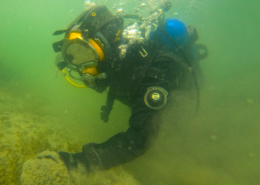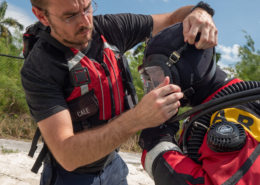Top Response teams, and what makes one better than another?
By Thomas Powell
In the United States today you can find dive teams of all shapes and sizes. Some teams are made up of volunteers, while others consist of paid workers. Some teams belong to law enforcement entities, while others may come from fire, emergency medical services, or rescue departments. Certain teams choose to maintain internal trainers, while others choose outsourced certification and training programs. These differences between dive teams establish differences in support, capabilities, and even motivation.
What makes one team better than another and how do we become the team that gets the call when divers are needed? That is a question that I get on a frequent basis. Many departmental or team leaders have goals and aspirations to create a team that can do anything and go anywhere. The hope is often to meet the federal FEMA requirements for qualification as a response team. What many team developers do not realize is that this can be a big task, and requires the support, dedication, and hard work of many individuals working toward unified goals.
Paid vs. Unpaid
First, the topic of volunteer teams versus paid teams must be discussed. This is a dangerous topic quietly discussed among instructors and public safety divers on a regular basis. The consensus is that paid teams are more dedicated to public safety operations and that volunteer teams are often unreliable. The reality is that reliability and dedication depend on the quality of service provided by individual team members, no matter what type of team they join. The truth of the matter is that any team should evaluate members to determine if they are physically able and mentally prepared to perform duties on a dive team. From that point, a team leader can monitor members to ensure that there is an essential level of dedication to the team. Many departments have team members who show up merely for the t-shirt and the possibility of a badge or uniform designator. These personnel are the ones who provide no value to the team and should be replaced by others who bring value to the table. In truth, paid dive team members can be fired for not performing job-based duties. Volunteers do not face this dilemma. No matter what type of team you run, develop, or join, remember that quality members are what make you successful. Work toward creating a standard that ensures safety, fitness, and shared team-based work.
Working Together
A second factor that can elevate the quality of a dive team is the ability to work with others. When a dive team of any type takes a call, various factors must be considered. Decontamination, scene security, and evidentiary collection are a few of these factors. If you run a dive team for a fire department, why would you not consider calling law enforcement to assist with scene security and evidentiary collection as needed? Conversely, if you run a team for a law enforcement department, why would you not consider calling your local fire department for decontamination support? In each of these cases, the supportive group is trained in the areas where they could offer assistance. With this in mind, why would you not establish training scenarios using support groups so you are better prepared when real missions occur? When a group is willing to accept help, focus can often remain on essential tasks. This focus can allow dive team personnel to perform their jobs in a more efficient manner without trying to juggle secondary tasks. When a team realizes that it is okay to ask for help, the ability to grow and perform at a more efficient level may develop.
Regular Training
The biggest factor that can make one team “better” than another is training. Too often have I seen teams that dive only a few times per year. Simultaneously, when training does occur only a few members show up, while every member shows up for a real call. This is an unacceptable situation that many dive teams face. Is a large membership roster really worth having personnel who are unprepared and untrained? Diving is an activity in which our skill sets can diminish. Over time we get rusty and need to practice what we know. One prime example of this can be seen in how fire fighters train and work every day. Fire fighters wear SCBA systems with a full face mask. In the public safety dive world this leads to comfort when donning a full face mask system for dive training and operations. Conversely, it also means breaking through a powerful comfort level when that same diver must bail out of a full face mask system and don a half-mask underwater. Dive teams must train to be comfortable in adverse situations. A short-sighted training schedule does not accomplish this objective.
Furthermore, many teams get excited when training is ramped up and classes are planned. Divers show up and good training occurs. The problem is that at some point funding or momentum will lapse. In recent years I have seen a handful of teams train through an ERD 1 or other basic public safety diver program. At that point, departmental heads have felt that the team is “trained” and no longer needs to move forward. The problem with this mindset is that further education may become neglected and replaced with educational maintenance. This lack of forward momentum often leads to reduced training attendance and a lull in the development of operational capabilities. Training is critical. It should be planned and occur on a regular cycle during which attendance is mandatory on some level. Simultaneously, departmental leaders who can approve training must be educated when possible so that they understand the value in continued training and support.
Innovation and Technology
Two things that can make any team “better” than before are innovation and technology. Imagine that your team has the ability to see underwater without the use of divers. Essentially, using sonar or unmanned systems, you can run search patterns, and even put eyes on specific items underwater without splashing a single diver. When something must be further inspected or an item must be recovered, you can then put your divers in the water for a minimal period. Now, take things one step further and imagine that modern technology would allow your divers to see with clarity through black water and turbidity. Compare that situation to one in which you must run your entire search using divers on tethers. This would require more time, and also requires personnel to be submerged in a potentially dangerous environment for longer periods. Your divers may also be searching in black water using tactile search methods when they cannot see.
The first scenario is one that can already exist. The technology is out there to expedite searches and improve diver safety. The problem often comes down to two factors. First, some teams do not wish to break away from methods they have been using for long periods and feel that new technology would only complicate searches. Second, funding for these types of technological innovations is often unavailable. The one thing to remember is that mutual aid agreements can often lead to the sharing of technologies between groups. Similarly, many technological companies that develop subsurface equipment do offer support when a team is attempting to acquire grant monies or other outside funding. Take the time to see what is available for your team and how you can accomplish missions more efficiently while reducing liability.
Forward Momentum
Divers often join dive teams wanting to learn to dive or they wish to use what they know to help others. This means that with new membership there is a level of forward momentum that is good for all parties involved. This motivation must be fostered. Encourage your divers to get wet. The more your divers hit the water the more experience they will gain. The more they dive together, even on “off time,” the more trust they will develop between one another. Trust and experience are the cornerstones of any great dive team. With regular training, and team support, forward momentum is something that can be maintained, but you must find ways to keep your divers active and learning.
Behavior
A final factor that is critical to the development of a quality dive team is behavior. Too often have I witnessed team members who do not stick around to clean up or decontaminate equipment. Similarly, I have seen joking, fussing, or otherwise bad social behavior in the public eye that has led to problems for the department that supports a dive team. In truth, public safety divers often do “off-gas” in socially unacceptable ways, and this is a proven factor in the public safety community. The problem is that there is a time and place for these things to occur. Dive team members must act like professionals and garner the respect of the departments that request their support. When a team can behave like professionals and then operate as an efficient machine, they will be viewed as a community asset.
Summation
So what makes a dive team great? The real answer lies in education, ability, professionalism, and experience. If you provide your divers with the resources and the backing to improve and to fix problems, then they will be able to handle the missions for which they have been trained. When you work to integrate support units or to provide new technologies, you only improve upon an already quality core structure. If you can find ways to build this structure properly, or repair the structure you already have, you will maintain a dedicated group of dive personnel who will earn a quality reputation based on professional focus and capability. With this type of backing, you can push forward to develop your team into whatever it needs to become.




 Y. ZIN
Y. ZIN




اترك رداً
تريد المشاركة في هذا النقاششارك إن أردت
لا تتردد في المساهمة!